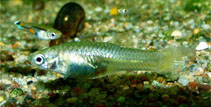| Family: |
Poeciliidae (Poeciliids), subfamily: Poeciliinae |
| Max. size: |
5 cm SL (male/unsexed); 6 cm SL (female) |
| Environment: |
benthopelagic; freshwater; brackish; pH range: 7 - 8; dH range: 9 - 19, non-migratory |
| Distribution: |
South America: Venezuela, Barbados, Trinidad, northern Brazil and the Guyanas. Widely introduced and established elsewhere, mainly for mosquito control, but had rare to non-existing effects on mosquitoes, and negative to perhaps neutral effects on native fishes (Ref. 12217). Africa: Feral populations reported from the coastal reaches of Natal rivers from Durban southwards, as well as in the Kuruman Eye and Lake Otjikoto in Namibia (Ref. 7248). Several countries report adverse ecological impact after introduction. |
| Diagnosis: |
Dorsal spines (total): 0-0; Dorsal soft rays (total): 7-8; Anal spines: 0-0; Anal soft rays: 8-10 |
| Biology: |
Inhabits warm springs and their effluents, weedy ditches and canals (Ref. 5723). Found in various habitats, ranging from highly turbid water in ponds, canals and ditches at low elevations to pristine mountain streams at high elevations (Ref. 11225). Occurs in wide variety of habitats with low predation pressure, usually in very small streams and densely vegetated lakes and springs (Ref. 59043). Has a wide salinity range but requires fairly warm temperatures (23-24 °C) and quiet vegetated water for survival (Ref. 7248, 44894, 79840). Feeds on zooplankton, small insects and detritus. One of the most popular aquarium fishes with many standardized varieties. Used in genetics research. Female reaches 5 cm SL (Ref. 2847). Males mature at 2 months and females at 3 months of age (Ref. 1672). Aquarium keeping: in groups of 5 or more individuals; minimum aquarium size 60 cm (Ref. 51539). A very popular and widely available species in the aquarium trade. In Australia, wild populations were established prior to the 1970s, undoubtedly the result of thoughtless aquarists discarding unwanted pets (Ref. 44894). Maximum length for female taken from Ref. 43281. |
| IUCN Red List Status: |
Least Concern (LC); Date assessed: 18 May 2020 Ref. (130435)
|
| Threat to humans: |
potential pest |
Source and more info: www.fishbase.org. For personal, classroom, and other internal use only. Not for publication.

